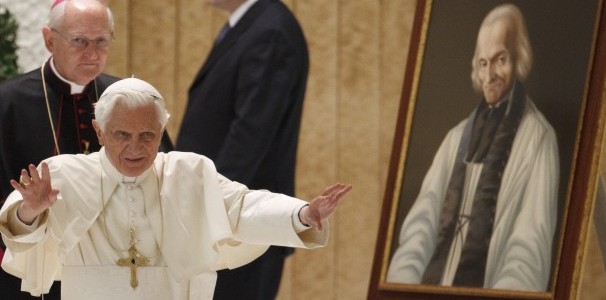

St. John Vianney - Educator of Holiness
Tim Theriault
Friday, August 3, 2012

Since his death on August 4th 1859, and especially following his canonization in 1925, St. John Vianney has been recognized as a person of outstanding virtue and priestly holiness. In recent years, however, the popularity of this saint has grown, thanks largely to the recent Year for Priests (June 2009 to June 2010). In his address inaugurating the Year for Priests, Pope Benedict XVI held up St. John Vianney, the Curé of Ars, as the supreme model for all parish priests; highlighting his love for the Eucharist and zeal for leading souls back to God through confession as traits necessary for today’s priests. Below is a brief excerpt from the Holy Father’s address:
Saint John Mary Vianney taught his parishioners primarily by the witness of his life. It was from his example that they learned to pray, halting frequently before the tabernacle for a visit to Jesus in the Blessed Sacrament. “One need not say much to pray well” – the Curé explained to them – “We know that Jesus is there in the tabernacle: let us open our hearts to him, let us rejoice in his sacred presence. That is the best prayer”…This way of educating the faithful to the Eucharistic presence and to communion proved most effective when they saw him celebrate the Holy Sacrifice of the Mass. Those present said that “it was not possible to find a finer example of worship… He gazed upon the Host with immense love”… This deep personal identification with the Sacrifice of the Cross led him – by a sole inward movement – from the altar to the confessional. Priests ought never to be resigned to empty confessionals or the apparent indifference of the faithful to this sacrament.The dedication and holiness with which Vianney humbly served the tiny village of Ars, France not only transformed the lives of its 230 residents, but soon began to affect the lives of Catholics throughoutFranceand across Europe. Thousands began traveling to Ars to hear Vianney’s powerful homilies and to have him hear their confessions; to the point where it was not uncommon for him to spend up to sixteen hours a day in the confessional. There is no doubt that St. John Vianney was an extraordinary priest; but can he be a realistic model for the priests of today, many of whom have multiple parishes and diocesan responsibilities? It is tempting, when looking to a saint for guidance, to become discouraged at how inadequately we measure up to their standing; but to give into this temptation would be to do the exact opposite of what the Church intended in giving us the saints. The saints are always there to be a source of encouragement; to show us that someone just as human as us, struggling with many of the same temptations and vices we struggle with, has, through their openness to God’s grace, attained eternal happiness in the beatific vision. Today’s priests, then, should not look to St. John Vianney and think that they could never be like him; rather, they are invited to look to his pastoral zeal and prayerful dedication as a way to approach the pastoral situation particular to their own parish and diocese. The laity are also invited and encouraged to pray to St. John Vianney, that he may intercede for their priests. As lay pastoral ministers become more of an integral part of every parish team, the life and holiness of St. John Vianney should encourage all to work tirelessly for the Gospel so that all may have a chance to dwell in the love of the heart of Christ.
Related Articles:
<<













